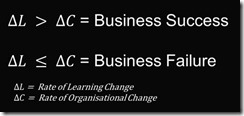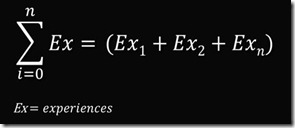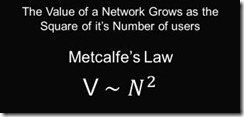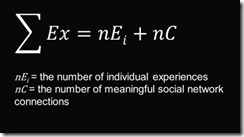Last month I took part in the iVentiv Executive Knowledge Exchange event in New York.
The two days of roundtable discussion were focused on ‘learning futures’. There were plenty of good conversations, some case studies, and lots of idea sharing and thoughts around innovation and the future of learning in organisations.
The event was attended by Chief Learning Officers and executives responsible for senior leader and employee development and corporate learning strategies in organisations such as Hertz, GE, Yahoo!, Dow Jones, Hitachi Data Systems, New York Life, CIGNA and the US Navy War College, among others. A great group of people with a huge amount of experience in the field.
Overall it was a very productive and worthwhile two days.
| Industrial Crowdsourcing |
Dealing with Change
One observation at the iVentiv event in particular left a lasting impression on me. This was a formula that Brad Benson described in a session he led titled Learning, Leadership and Change. Brad is Chief of Staff at Intel, so has lived in the white heat of change in a large organisation. He spends his time thinking about ways of applying executive development approaches to the development of corporate strategy.
The formula Brad described was this:
L > C
Where L= the Rate of Learning and C= the Rate of Change
Brad explained this in terms of the changing leadership and thought-leadership at Intel over the years – from the days of Robert Noyce and Gordon Moore through Andy Grove and Craig Barrett to Paul Otellini. He posited that organisations need to ensure that the rate of learning is always greater than the rate of change the organisation is grappling with – both internal change and the external change that is impacting the organisation.
Basic CLO Maths – the L and C dimensions
Brad’s formula got me thinking about the fact that it might help CLOs if they had a grasp of some of the basic maths of learning and performance.
I dragged some of my basic maths back from the depths of long-term memory and extrapolated Brad’s formula a little to describe the implications of the relative rates of change between Learning and Organisations themselves. It seemed sensible to me to express the relationship as relating to business outcomes:

From this I figured we can derive a modification of Brad’s formula:
If the rate of change in learning is greater than the rate of organisational change (the sum of internal and external change) then the outcome will contribute to business success.
If, however, the rate of change in learning is less than or equal the rate of organisational change, then the outcome will contribute to business failure. The CLO can pack his/her bags and look for other pastures.
That seemed pretty clear to me. We know that relevance and speed are two of the fundamental elements of effective learning in organisations. So being aware of rates of change and being able to respond seems to be a pretty fundamental skill of any CLO.
Organisations change
In most verticals and regions the rate of organisational change is increasing. In many cases the increase has very been rapid over the past few years, and the velocity is still increasing. In others it may not have been so fast, but no organisation is protected from change. External economic factors and the whims of financial markets see to that.
As the old adage says ‘sometimes you have to run to stand still’.
The approaches deployed in our learning and employee development strategies 10 years ago are mostly no longer valid or useful for our new organisational contexts – there are too many new variables involved and our contexts have changed inexorably. We need to continually evolve our approaches, adopt new ones, look outside our own organisation for different strategies that work, and then build those that our judgement tells us will fit into our own context.
CLO Maths – the E and K dimensions
There’s some further maths that I think CLOs might find useful.
The formula below explains the importance of experiences in learning.
This formula states that the Sum of Experiences plus the Change in Fixed Knowledge should be greater than the Rate of Change of the Work Context.
It describes the relationship between fixed knowledge – the type we learn through reading and classes - and the learning we acquire through experiences and good conversations. Ideally, learning through experiences is incorporated into formal learning programmes, but I’ve rarely seen it. In my experience the vast majority of formal learning is content-rich and experience-poor. It’s easier that way.
There are three variables here. CLOs can have some influence over the first two only – the number of experiences and the level of fixed knowledge. The Work Context is out of the CLO’s hands, although it is one of the main drivers. It’s a very challenging problem.
The value of fixed knowledge is degrading exponentially as the rate of change and externalities increase.
Also, the number of experiences to which employees can be exposed is arithmetic.
We can help manage this problem to some extent by recruiting people who bring experience with them. But that doesn’t solve the problem of the need for experiences that are tied to the context of work that happens in our own organisations – each organisation will overlay its own specific context.
Network Theory
CLOs might also find network theory helpful to understand what they can do to reduce the impact of the arithmetic nature of experiences.
Metcalf’s Law is a good start. Bob Metcalf, who created Ethernet and founded 3Com, defined a law that states:
There have been some recent challenges to Metcalfe’s Law’s application to social networks, but I side with Metcalfe's Defence.
If we think of Metcalfe’s Law in terms of social networks we can deduce this:
“the value of a network equals the square of the number of networked employees”
So it seems we can use social networking in organisations to break the arithmetic limitations of learning through experience.
That led to thinking a little more about the power of social networks in relation to experiences. I came up with this thought:
The sum of experiences is equal to all the individual experiences an employee has PLUS the number of meaningful social network connections.
If this equation holds, there is significant value-add if a CLO’s team can assist employees to build connections through social networks within and outside the organisation (we know this is the case from observation, anyway). Apart from other benefits social networks will bring, meaningful connections extend the pool of individual experiences and break the linear relationship.
If CLOs can make this maths work then their organisation will move forward.
The Value of Experiences
I think it’s worth reiterating that the experience element in the formulae above is critical. Without rich and on-going experiences – challenging projects, new responsibilities, exposure to other organisations’ way of doing things and other parts of our own organisations’ way of doing things we simply won’t have the level and extent of experiences that we need to succeed and develop.
My own experiences in a working life spent exploring learning and performance has led me to believe that exposure to new experiences is one of the important, if not the most important, aspects of learning and capability-building. Jay Cross, my colleague in the Internet Time Alliance, turned the experience-conversation lights on for me a few years ago when he said ‘experience and conversations are the engine room of learning, and conversation is the first learning technology’.
--------
I’m working on some more CLO maths and will post Part II here at some point.
If better mathematicians than me would like to correct or expand any of the above, I’d welcome your thoughts.







